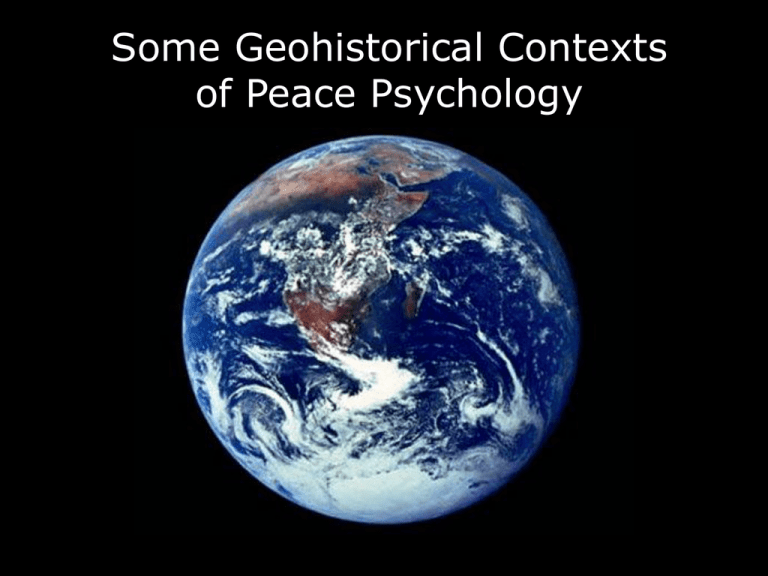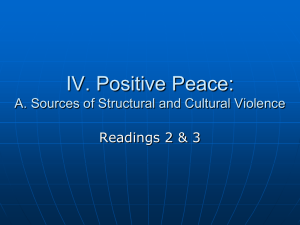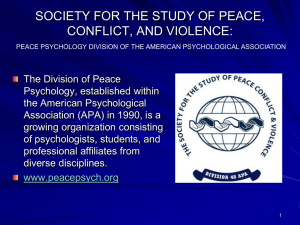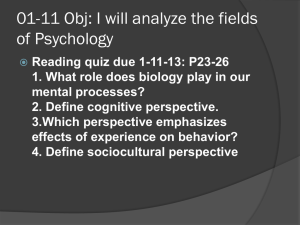IC.Geohist Context - Asia - Society for the Study of Peace
advertisement

Some Geohistorical Contexts of Peace Psychology THE PEACE PSYCHOLOGY BOOK SERIES Springer Science + Business Media (Springer SBM) Books in the Series (as of February 2009) • Global Conflict Resolution through Positioning Analysis by Moghaddam & Harre (2008) • Liberation Psychology: Theory and Practice by Montero & Sonn (2009) • Handbook on Building Cultures of Peace by de Rivera (2009) • Transforming Societies after Political Violence: Truth, • Reconciliation, and Mental Health by Hamber (2009) • Nonviolence and Peace Psychology by Mayton (2009) • Forgiveness and Reconciliation: Psychological Pathways for Conflict Transformation and PeaceBuilding by Kalayjian and Paloutzian (2009) • Peace Psychology in Asia by Montiel & Noor (2010) • Small Group Research: Applications to Peace Psychology and Conflict Resolution by Blumberg, Hare, Kent, & Davies (in preparation) • Youth Violence: Reflections from and on the Field by Michael Greene (in preparation) • Forging Peace under Fire? Reconciliation-aimed Encounters between Israeli-Jews and Palestinians by Ifat Moaz (in preparation) Books with Geohistorical Focus Latin Amer. S. Africa Asia Middle East Cristina Montiel Noraini Noor Peace Psychology in Asia Montiel & Noor (2009) Chapters I. Introduction to Peace Psychology in Asia 1 Overview of Peace Psychology in Asia: Research, Practice and Teaching Cristina Jayme Montiel, Ateneo de Manila University 2 Culture, Social Representations, and Peacemaking: A Symbolic Theory of History and Identity James H. Liu, Victoria, University of Wellington and Chris G. Sibley, University of Auckland II. South Asia 3 Where Are We Going? Perspective on Hindu-Muslim Relations in India Sammyh S. Khan, Victoria University of Wellington and Ragini Sen, Logistics, Mumbai, India 4 Political Violence and Peacebuilding in Jammu & Kashmir Waheeda Khan, Jamia Millia Islamia University Peace Psychology in Asia Montiel & Noor (2009) III. Southeast Asia 5 Peace Psychology of Grassroots Reconciliation: Lessons Learned from “Baku Bae” Peace Movement Hamdi Muluk, Universitas Indonesia & Ichsan Malik, Indonesian Peace Building Institute 6 Memory for Sale: How Groups “Distort” their Collective Memory for Reconciliation Purposes and Building Peace Hamdi Muluk, University of Indonesia 7 Contested Discourses on Violence, Social Justice and Peacebuiding Among Indonesian Muslims Yayah Khisbiyah, Muhammadiyah University of Surakarta 8 Interreligious Harmony and Peacebuilding in Indonesian Islamic Education Florian Pohl, Oxford College of Emory University 9 The future of Malay-Chinese relations in Malaysia Noraini M. Noor, International Islamic University Malaysia 10 A Positioning Analysis of Moro Women’s Participation During and After the MNLFGRP War Brenda S. Batistiana, Ateneo de Manila University 11 Human–Technology Interface in Philippine People Power Ma. Regina E. Estuar and Cristina J. Montiel, Ateneo de Manila University Peace Psychology in Asia Montiel & Noor (2009) IV. East Asia 12 Forgiveness for Conflict Resolution in Asia: Its Compatibility with Justice and Social ControlKen-ichi Ohbuchi and Naomi Takada, Tohoku University 13 Toward reconciliation of historical conflict between Japan and China: Design science for peace in Asia Tomohide Atsumi, Osaka University and Koichi Suwa, Osaka City University 14 Is The Third Way Possible for Peace? The Dilemma of National Identity in Taiwan and Beyond Li-Li Huang, National Tsing Hua University 15 Income Gap, Materialism and Attitude towards the Rich in China Fan Zhou, Zhejiang University V. Future of Peace Psychology in Asia 16 How Asia Can Contribute to World Peace Psychology: Creating a Dignified and Peaceful World by Employing Unity in Diversity Evelin Lindner, Founder of Human Dignity and Humiliation Studies 17 The Future of Peace Psychology in Asia Noraini M. Noor, International Islamic University Malaysia Peace Psychology in Asia (Montiel & Noor, 2009) Chapter 1: Thematic Overview (Montiel, 2009) – European Colonization and Ethnic Divisions Colonization and Ethnic Divisions: Hindu-Muslim Khan & Sen (2009) in Montiel and Noor (Eds.) Colonization & Ethnic Divisions in Malaysia Noor (2009) in Montiel and Noor (Eds.) Malay Indian Malaysian Chinese Malaysian Colonization and Ethnic Divisions: Christian-Muslim Muluk & Malik (2009) in Montiel and Noor (Eds.) Peace Psychology in Asia (Montiel & Noor, 2009) Chapter 1: Thematic Overview (Montiel, 2009) – European Colonization and Ethnic Divisions – Japan’s Occupation and Continued Animosities China-Japan Relations: Continued Animosities about the Nanjing Massacre & Japanese Occupation (1931-45) China-Japan Relations: Atsumi & Suwa (2009) in Montiel and Noor (Eds.) Redressing Continued Animosities about the Nanjing Massacre & Japanese Occupation (1931-45) through disaster relief A Japan Disaster Relief Team in Qushan, Beichuan County, working at a middle school affected by the Sichuan earthquake (Photo courtesy of the Japan International Cooperation Agency) China-Japan Relations: Generational Change Naïve Universalism? Atsumi & Suwa (2009) In Montiel & Noor (Eds.) Japanese students display the Chinese characters meaning "separated by a narrow water" referring to the geographic neighborhood between China and Japan, during their visit in Hangzhou, capital of east China's Zhejiang province (March, 2008) Colonization & Forgiveness in Korea-Japan Relations Ohbuchi & Takada (2009) in Montiel and Noor (Eds.) Japan, Korea to Join Hands to Aid Afghanistan (2009) Japan-Korea 2002 World Cup Logo For the first time in its history, the World Cup was organized by two countries. South Korea and Japan each provided ten stadia, the vast majority of them newly built for the tournament President Lee Myung-bak and Japanese Prime Minister Taro Aso launch joint projects, constructing schools and hospitals through a partnership between the Korea International Cooperation Agency and the Japan International Cooperation Agency. (Jan. 09) Peace Psychology in Asia (Montiel & Noor, 2009) Chapter 1: Thematic Overview (Montiel, 2009) – European Colonization and Ethnic Divisions – Japan’s Occupation and Continued Animosities – Nonviolent Democratization Movements Nonviolent Democratization Movements Estuar & Montiel (2009), in Montiel and Noor (Eds.) Estonia, Lithuania, Latvia ‘87 Ukraine East Germany ‘89 ‘04 South Korea Nepal ‘87 Taiwan ‘86 ‘06 Thailand ‘92 Mexico ’88-early ‘90’s Philippines ’86, ‘01 Indonesia ’98-‘99 East Timor ‘02 Chile ’83‘88 South Africa ‘94 Nonviolent Transitions from 1985-2006 (from Montiel and Christie, 2008) Peace Psychology in Asia (Montiel & Noor, 2009) Chapter 1: Thematic Overview (Montiel, 2009) – European Colonization and Ethnic Divisions – Japan’s Occupation and Continued Animosities – Nonviolent Democratization Movements – Culture and Peace Psychology Culture and Peace Psychology: Indigenous Peacebuilding Muluk & Malik (2009), in Montiel and Noor (Eds.) Baku Bae and Indigenous Peacebuilding Peace March in Ambon Culture and Peace Psychology: Religion and Social Justice People Power & Cardinal Sin Episodic versus Structural Peacebuilding • Reduces Direct Violence • Reduces Structural Violence • Power differences ignored • Power differences reduced • Serves the status quo • Threatens the status quo Peace Psychology in Asia (Montiel & Noor, 2009) Chapter 1: Thematic Overview (Montiel, 2009) – European Colonization and Ethnic Divisions – Japan’s Occupation and Continued Animosities – Nonviolent Democratization Movements – Culture, Religion, and Peace Psychology – Direct and Structural Peace In Asia: Emphasis on Structural Violence Episodic Violence • • • • Also called direct violence Kills/harms quickly Intermittent Acute insult to well-being • Episodes may be prevented • Dramatic Structural Violence Also called indirect violence Kills/harms slowly Continuous Chronic insult to well-being Inertia may be mitigated Normalized And Links between Structures & Episode of Violence and Peacebuilding Episodic Violence Episodic Violence Peacebuilding Episodic Peacebuilding Structural Systemic Violence Structural Violence Systemic Peacebuilding Structural Peacebuilding (Christie, JSI, 2006) Peace Psychology in Asia (Montiel & Noor, 2009) Chapter 1: Thematic Overview (Montiel, 2009) – European Colonization and Ethnic Divisions – Japan’s Occupation and Continued Animosities – Nonviolent Democratization Movements – Culture, Religion, and Peace Psychology – Direct and Structural Peace – The Importance of Collective Subjectivities The Importance of Collective Subjectivities Atsumi & Suwa (2009) in Montiel and Noor (Eds.) Scientific Traditions Nomothetic Goal: Universal laws through hypothesis testing. Epistemic Question: What is it? Goals are description, explanation, control, and prediction Design Question: What do you want to do? Goals are plan, action, evaluaton. Natural Sciences Physics Social Psychology Engineering Action Research Narrative Goal: Describe characters, plots, narratives, and interpretations. Humanities & Political Science Peace Psychology in Asia Social Representations of History Liu & Sibley (2009) in Montiel and Noor (Eds.) Social Narratives and the destruction of the Babri Masjid monument in Ayodhya, 6 December 1992.









